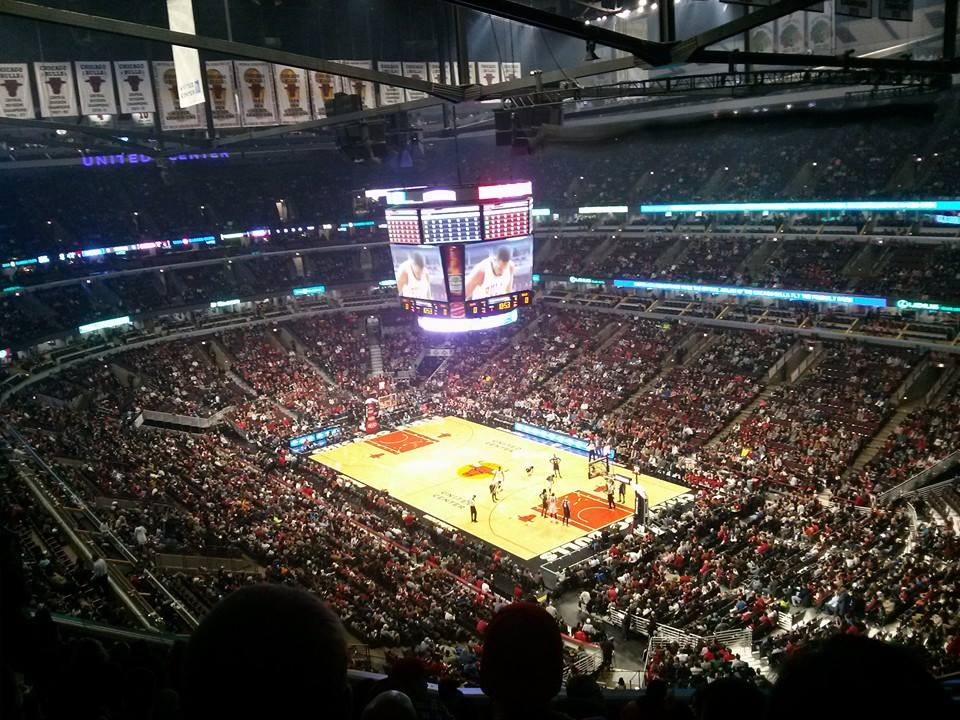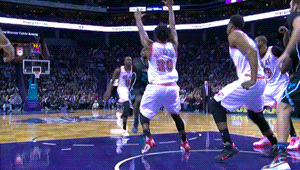The youngest triple-double in NBA history. And I was there. Because I’m an accredited member of the media? Ha. Not even close. I do try to make it to a game or two in either Chicago or Milwaukee each season, and I’m usually fortunate enough to sit in seats with views like this with some good friends.

Last Saturday night in Milwaukee.

A few years ago in Chicago. See? They reserve these in-demand seats for me at both arenas. Sidenote: My Bulls recently scored seven points in a quarter, which is only one point less than Reggie Miller once scored in nine seconds.
So, Lonzo Ball put up a very impressive stat line that night with his 19/12/13 triple-double. And, as you’ve likely heard, he was five days younger than LeBron James was when he’d set the record for youngest triple-double. And if you watched ESPN’s highlight package for this game, you were treated to six Lonzo plays focusing on his accomplishment followed by one Giannis Antetokounmpo put-back dunk and a brief mention that, oh yeah, the Bucks actually won the game. Now, I’m quite the Lonzo apologist, and I spent far too much of the last year studying his game because of how much it impresses me… but ENOUGH WITH THE TRIPLE-DOUBLE MANIA! I’ve previously mentioned my disdain for how much these stat lines get overrated simply because an arbitrary number was reached in three categories. If we had 18 fingers and had decided on a base-18 number system thousands of years ago, a triple double would really be something, but is 10/10/10 a worthy threshold for what should be considered a noteworthy game? The thing that really bothers me is that, these day, even a “near-triple-double” will often get more attention than a more valuable stat line, even if it’s only like 11/8/9 (a Rajon Rondo Special). For example, Giannis went 33/15/3 that same night. Is that more valuable? It depends on whether you’re talking about value to the player’s actual NBA team or to our fantasy teams. When it comes down to who was more effective in the actual game, there are plenty of stats that try to figure that out. A simple one is plus/minus where Lonzo was +10 and Giannis was +13. That depends on who’s on the court with you, though. There’s John Hollinger’s Player Efficiency Rating. Basketball Reference has a game score, as well. I guess we nerds will continue to try to whittle down a player’s performance into one number, for whatever it’s worth.
Now, value in fantasy is different. And that’s what we care about here. I recently wrote about some basics of where the ESPN Player Rater and the Yahoo Standard Deviation values come from, mainly by seeing how far away players’ stats were from the average. I briefly mentioned that it’s important to remember that certain stats are more valuable than others because of how scarce they are. That’s pretty obvious when you compare something like rebounds to blocks, but today, we’ll look more closely so that we can get a handle on exactly how valuable each stat category is relative to the others. That should allow us to better judge a player’s worth to us as fantasy owners at a glance, be it one game or a season average. Clearly, this won’t be the most effective way to rate the actual NBA effectiveness of a stat line. As we’ll later see, a block is 22 times more rare than a point, yet it’s clearly not worth that much more to a real team… even if it sometimes feels like it.

This won’t take into account exactly how valuable the outliers are, how a player compares to a replacement player, or take positional scarcity into account, among other criteria that player raters use. Keep in mind, also, that your fantasy team and your opponents’ teams determine a lot about how much stats are worth to you. This is just something I always wanted to know. A quick look at how each category should be weighted to even them out. I started with the average number of each stat per team per game (through 11/13):
| 3PTM | PTS | REB | AST | ST | BLK | TO |
| 10.35 | 105.39 | 43.77 | 22.16 | 8.14 | 4.79 | 15.13 |
Another caveat: team rebounds might be included here, so REB values might be a bit understated, as they’d be more scarce than these numbers indicate. Also, I skipped the shooting percentages, as that’s a little harder to quantify with it’s percentage and volume.
Since points is the most prevalent category, and since we probably all pay the most attention to it, I’m making a point our standard unit of measure. Now, here are how many “points” each stat is worth.
| 3PTM | PTS | REB | AST | ST | BLK | TO |
| 10.19 | 1.00 | 2.41 | 4.76 | 12.95 | 22.02 | -6.97 |
This tells us that it takes 10 points to equal one three-pointer, 13 points to equal one steal, etc. So, when you’re checking out box scores or your fantasy team page, keep this in mind. In fantasy, most of us overrate points, since they’re what matter most in real life, but it’s just one category. Maybe think of this as a guide to how excited to be when one of your players acquires a fantasy statistic.
So, back to comparing stat lines. What’s your most basic triple-double worth? 10/10/10 would translate to 10+24.1+47.6=81.7
With this information, we can also determine that, for points/rebounds/assists, 10/10/10 is exactly as statistically scarce as these examples:
46/5/5
34/10/5
22/5/10
58/10/0
34/0/10
0/15/10
0/10/12
82/0/0
0/34/0
0/0/17
Of course, more categories are almost always involved in a stat line (not to mention the shooting percentages, which can impact your team a ton in high-scoring games). Below are the Lonzo and Giannis games from that night (Lonzo did have some spectacular supporting stats) along with a handful of memorable games this season that impressed me, fantasy-wise.

Should I come up with a name for this point total? The… Counting-Stat Normalization… Palooza? I’ll work on it. You can see how the big steals and/0r blocks games really add up. Feel free to play with these weights to see what crazy totals you can come up with from spectacular games or seasons.
Sure, this is fun (if you’re anything like me), but how can we use this new perspective for our gain? Take advantage of peoples’ tendency to overrate the points category, and try not to do so, yourself. Trade a Rip Hamilton-type player that’s almost all points for a guy like the sneaky-valuable Joe Ingles (2.4 treys, 4.5 boards, 3.7 dimes, 1.4 swipes), for example. Hopefully this changes the way you look at stat lines, especially if you’ve been guilty of focusing mostly on those dang triple doubles.
This week’s classic fantasy line:
Using this new value system, I thought I’d see how some of my favorite steals+blocks guys at their peaks compared with a Hall of Famer at his peak. Admittedly, all three of the guys I picked greatly benefit from having the percentages withheld from the equation.





